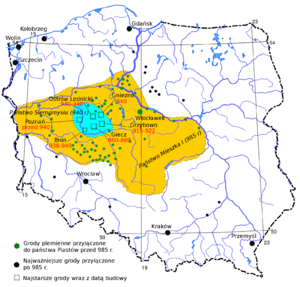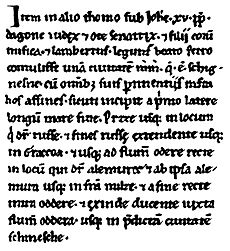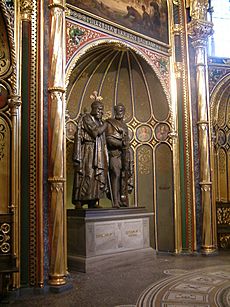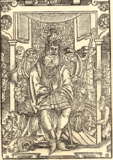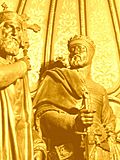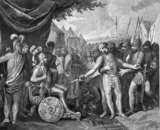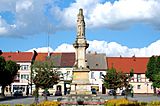Mieszko I facts for kids
Quick facts for kids Mieszko I |
|
|---|---|
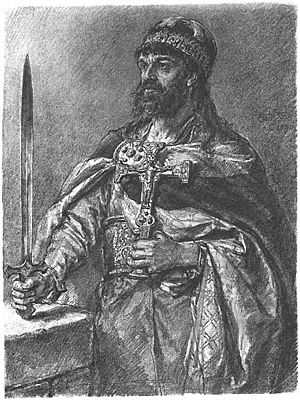 |
|
| Duke of Poland | |
| Reign | 960–992 |
| Predecessor | Siemomysł |
| Successor | Bolesław I the Brave |
| Born | c. 930 |
| Died | 25 May 992 (aged 61–62) Poznań, Poland |
| Spouse | Doubravka of Bohemia Oda of Haldensleben |
| Issue more... |
Bolesław I the Brave Świętosława Vladivoj, Duke of Bohemia (?) Mieszko Świętopełk Lambert |
| Dynasty | Piast |
| Father | Siemomysł |
| Religion |
|
Mieszko I (Polish pronunciation: [ˈmjɛʂkɔ ˈpjɛrfʂɨ]; around 930 – 25 May 992) was a very important ruler in Polish history. He was the first leader of Poland and helped create the first independent Polish state, known as the Duchy of Poland. He ruled from about 960 until his death in 992. Mieszko I was part of the Piast dynasty, a powerful family that ruled Poland for centuries. He was the son of Siemomysł and the grandson of Lestek.
Mieszko I is famous for being the first Christian ruler of Poland. His decision to become Christian in 966 changed Poland's future forever. He continued the work of his father and grandfather, who had started building the Polish state. Mieszko used both alliances and military strength to expand Poland's lands. He conquered areas like Kuyavia, Gdańsk Pomerania, and Masovia. He also fought for control of Western Pomerania and won Silesia and Lesser Poland. Because of his role in making Poland a Christian nation, some people call him the "Clovis of Poland."
Contents
- Early Life of Mieszko I
- Mieszko I's Reign
- Starting His Rule
- Battles and Alliances
- Dealing with German Neighbors
- Marriage and Becoming Christian
- Conquering Pomerania
- War with Margrave Odo I
- Expanding Eastward
- Second Marriage and German Politics
- Alliances and Wars
- Taking Silesia and Lesser Poland
- The Dagome Iudex Document
- Death and Succession
- Mieszko I's Legacy
- Marriages and Children
- Gallery
- See also
Early Life of Mieszko I
Historians don't know much about Mieszko I's early life before he became ruler. One old chronicle says he was born between 920 and 931, but this source isn't always reliable. Most historians think he was born closer to 945.
A legend says Mieszko was blind for the first seven years of his life. This story probably wasn't about actual blindness. Instead, it was a way to describe his early life as a pagan before he became Christian.
Mieszko I's Reign
Starting His Rule
Mieszko I became ruler after his father died, probably around 960. When he took over, he inherited lands where the Polans and Goplans lived, as well as the Sieradz-Łęczyca lands and Kuyavia. It's also possible that Masovia and Gdańsk Pomerania were part of his state. Mieszko's main challenge was to unite these different areas and tribes into one strong country.
Around 966, a Jewish traveler named Abraham ben Jacob described Mieszko I. He said Mieszko was one of four powerful "kings" of the Slavs, ruling a large northern area with a strong army.
Battles and Alliances
Mieszko I continued to expand his lands. He likely conquered Masovia and parts of Gdańsk Pomerania early in his rule. His main focus was on the areas near the Oder River.
Around 960, Mieszko started fighting against the Velunzani and Lutici tribes. A Saxon nobleman named Wichmann the Younger led some Slavic groups and defeated Mieszko twice. Mieszko's brother was even killed in one of these battles around 963.
Dealing with German Neighbors
In 963, a German leader named Gero conquered lands near Poland. This brought him into direct contact with Mieszko's state. Some historians believe Gero's actions forced Mieszko to pay tribute to the German Emperor Otto I. This tribute likely applied only to the Lubusz land, which was close to German influence. By 967, Mieszko was seen as a friend or ally of the Emperor.
Marriage and Becoming Christian
In 964, Mieszko started talking with the Czech ruler Boleslav I. This led to Mieszko marrying Boleslav's daughter, Dobrawa, in 965. This marriage was a political alliance between Poland and Bohemia.
The next big step was Mieszko's baptism in 966. This was a very important political decision. It helped Mieszko's state become closer to the Czechs and allowed him to expand his influence. Becoming Christian also made it less likely that German leaders would attack Poland to force Christianity on them. It also helped Mieszko gain more control over his own country by reducing the power of pagan priests.
The exact place of his baptism is not known, but it was a major turning point for Poland. Many religious words in Polish came from the Czech language, suggesting that Dobrawa and her group played a big role in bringing Christianity to Poland.
Conquering Pomerania
After making peace with the Holy Roman Empire and Bohemia, Mieszko I focused on conquering Western Pomerania. On September 21, 967, Polish and Bohemian troops won a big battle against the Wolinians, giving Mieszko control over the mouth of the Odra River. This victory was important for Mieszko, especially since he had been defeated by Wichmann before.
War with Margrave Odo I
In 972, Poland was attacked by Odo I, Margrave of the Saxon Ostmark. Odo acted on his own, without the Emperor's permission. He likely wanted to stop Poland's growing power or protect the Wolinian state. Odo's forces fought Mieszko's army at a village called Cidini, now known as Cedynia. Mieszko's brother Czcibor helped defeat the Germans. Some believe Mieszko tricked the Germans by pretending to retreat, then launching a surprise attack.
After this battle, Mieszko and Odo were called to a meeting in Quedlinburg in 973 to explain what happened. The Emperor died soon after, so the decision was never fully carried out. This victory at Cedynia helped Mieszko secure Western Pomerania.
Expanding Eastward
Archaeological findings suggest that Mieszko's state grew to include the Sandomierz region and the Przemyśl area in the 970s. These lands were important for trade and for future expansion. Some historians think Mieszko took these areas to prepare for taking over Lesser Poland, which was then controlled by Bohemia.
Second Marriage and German Politics
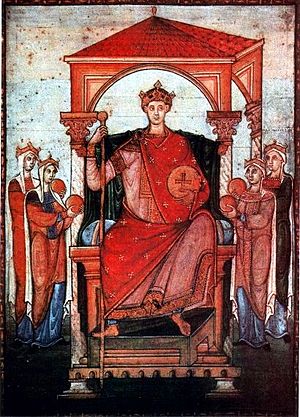
After Emperor Otto I died in 973, Mieszko supported a different leader, Henry II, Duke of Bavaria, for the German throne. This might have been because of the earlier meeting in Quedlinburg. However, Henry II was defeated, and Otto II became Emperor.
In 977, Mieszko's first wife, Dobrawa, died. In 979, Otto II may have attacked Poland, but the details are unclear. The Polish-German agreement was made in 980. Around this time, Mieszko I married Oda, the daughter of a German leader named Dietrich of Haldensleben. Oda was a nun, and Mieszko took her from a monastery. This marriage helped Mieszko gain more respect and allies among the German nobles.
Alliances and Wars
In the early 980s, Mieszko made an alliance with Sweden against Denmark. This alliance was sealed when Mieszko's daughter, Świętosława, married the Swedish king Erik. This helped protect Mieszko's lands in Pomerania from the Danish kings. The Danes were defeated around 991.
When Emperor Otto II died in 983, there was a lot of unrest in Germany. Mieszko and the Czech duke Boleslav II again supported Henry II, Duke of Bavaria for the throne. However, Henry II soon gave up his claim.
Mieszko then changed his support to the young Emperor Otto III. This was likely because of a Slavic uprising that threatened both Poland and Germany. In 985, Mieszko helped the Saxons fight against some Slavic forces. In 986, Mieszko met with Emperor Otto III and gave him gifts, including a camel. This meeting strengthened the alliance between Poland and Germany.
Taking Silesia and Lesser Poland
The good relationship between the Czechs and Poles ended, leading to a war in 990. Mieszko, supported by Empress Theophanu, fought against Bohemia. As a result, Silesia became part of Poland. It's possible that Silesia was taken even earlier, around 985, because major Polish strongholds were being built there.
The takeover of Lesser Poland is also debated by historians. Some think Mieszko took it before 990. After it was conquered, Lesser Poland might have been given to Mieszko's oldest son, Bolesław.
The Dagome Iudex Document
Near the end of his life, around 991-992, Mieszko I, his wife Oda, and their sons created an important document called Dagome iudex. In this document, Mieszko placed his lands under the protection of the Pope and described their borders. Only a summary of this document has survived.
Historians have two main ideas about why Mieszko created this document:
- It might have been to set up a proper Catholic Church organization across Poland. This would mean Poland would pay a special tax to the Pope, called Peter's Pence.
- It might have been to protect the interests of his second wife, Oda, and their sons after Mieszko's death. His oldest son, Bolesław, was not named in the document.
The Dagome iudex is very important because it gives us a general idea of where Poland was located at the end of Mieszko's rule.
Death and Succession
Mieszko I remained loyal to the Holy Roman Empire in his last years. He died on May 25, 992, likely from natural causes. He was probably buried in the Poznań Cathedral, but his remains have never been found.
Before his death, Mieszko I divided his state among his sons: Bolesław I the Brave, Mieszko, and Lambert. However, after a struggle, Bolesław I took control of all of his father's lands and sent his stepmother Oda and her sons away from Poland.
Mieszko I's Legacy

Mieszko I is remembered for uniting the Polish lands. His state was the first that could truly be called Poland. He is seen as the founder and builder of the Polish state. His decision to accept Roman Catholicism brought Poland into the main European civilization and political systems.
He supported the building of churches, including the Gniezno Cathedral. It's also likely he started the church at Ostrów Tumski and the Poznań Cathedral. Poland also started making its own coins, called denarius, during his time or soon after.
By the end of his rule, Mieszko I had doubled the size of the territory he inherited. He added important regions like Silesia, Western Pomerania, and probably Lesser Poland with Kraków. He was a skilled leader who used diplomacy and military strength wisely.
Mieszko I is honored today and is featured on the 10 Polish złoty banknote.
Marriages and Children
Before becoming Christian, Mieszko had seven pagan wives, but he had to leave them when he married Dobrawa. We don't know anything about children from those earlier marriages.
In 965, Mieszko married Dobrawa (born 940/945 – died 977). They had two children:
- Bolesław I the Brave (born 967 – died June 17, 1025).
- Świętosława/Sigrid the Haughty (born 968/972 – died around 1016). She married the Swedish king Erik and later the Danish king Sweyn Forkbeard. She was likely the mother of Cnut the Great, who became King of Denmark, Norway, and England.
Some historians believe Mieszko had another daughter who married a Pomeranian prince. There's also a theory that Vladivoj, who ruled Bohemia for a short time, was a son of Mieszko and Dobrawa, but most modern historians don't agree with this.
In 978/979, Mieszko married Oda of Haldensleben (born 955/960 – died 1023). She was the daughter of Dietrich of Haldensleben. They had three sons:
- Mieszko (born around 979 – died after 992/995)
- Świętopełk (born around 980 – died before 991?)
- Lambert (born around 981 – died after 992/995).
After Mieszko's death, his oldest son Bolesław I took control of the entire state. He sent his stepmother Oda and her sons away from Poland.
Gallery
-
Wichmann the Younger Surrenders to the Polish Prince Mieszko by Franciszek Smuglewicz (early 19th c.)
See also
 In Spanish: Miecislao I para niños
In Spanish: Miecislao I para niños
- Prehistory and protohistory of Poland
- Poland in the Early Middle Ages
- History of Poland (966–1385)
- List of Poles


